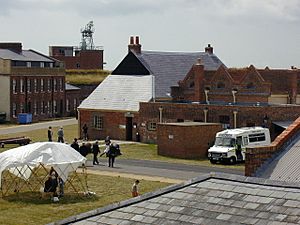Fort Cumberland (England) facts for kids
Quick facts for kids Fort Cumberland |
|
|---|---|

Interior of the fort.
|
|
| Type | Palmerston fort |
| Location | Southsea |
| OS grid reference | SZ 68283 99138 |
| Area | Hampshire |
| Built | 1785–1812 |
| Owner | English Heritage |
|
Listed Building – Grade II
|
|
| Official name: Fort Cumberland, City of Portsmouth | |
| Designated | 30 October 1969 |
| Reference no. | 1104273 |
| Official name: Fort Cumberland | |
| Designated | 16 March 1964 |
| Reference no. | 1015700 |
| Lua error in Module:Location_map at line 420: attempt to index field 'wikibase' (a nil value). | |
Fort Cumberland is a historic military fort in Southsea, England. It was built to protect the entrance to Langstone Harbour. This was important for keeping the Royal Navy Dockyard safe. The fort stopped enemies from landing and attacking by land.
Fort Cumberland has a unique five-sided shape. It is known as one of the best examples of a "bastion trace" fort in England. Today, it is a scheduled monument and a Grade II* listed building. This means it's a very important historical site.
Contents
Building Fort Cumberland: The First Fort (1747-1785)
The first fort on this spot was started in 1747. It was built by the Duke of Cumberland. Before this, there was a small earth wall built in 1714.
The first fort was mostly made of earth. It had an irregular star shape. Its defenses included:
- A glacis: A gentle slope leading up to the fort.
- A covered way: A hidden path for soldiers.
- A dry ditch: A deep trench around the fort.
- A rampart: A wide bank of earth forming the main wall.
- A parapet: A low wall on top of the rampart to protect soldiers.
- A terre-plein: The flat area behind the parapet where guns were placed.
Inside the fort, there were brick buildings. These included a guardhouse, a storeroom, and a powder magazine. Only one of the two planned barrack blocks was likely finished.
Building Fort Cumberland: The Second Fort (1785-1812)
The fort was completely rebuilt starting in 1785. This time, it was made of strong stone, called masonry. It was also much bigger than the first fort. The main construction was finished by 1812.
During this new build, almost all traces of the first fort were removed. Only the old guardhouse and storeroom were kept. They were included in the new design. The second fort covers about 24 acres (97,000 square meters). It has a different layout from the first.
This new fort is pentagonal, meaning it has five sides. It features five bastions, which are pointy parts of the wall that stick out. It also has a ravelin on its western side. A ravelin is a triangular outpost in front of the main wall.
Fort Cumberland was the last fort in the United Kingdom built with angle bastions. It was also the first to have casemated ordnance. This means its cannons were placed inside strong, arched rooms within the walls. This protected them from enemy fire.
Upgrading the Guns: The 1850s - 1860s
By the late 1850s, new types of cannons were invented. These were called rifled cannons. They were much more accurate than the old smooth-bore muzzle-loading guns. The fort's old guns became outdated.
In 1858, the fort was given to the Board of Admiralty. In 1859, it became the main base for the Royal Marine Artillery. Between 1860 and 1861, the fort's defenses were improved. This was to fit the new Armstrong guns, which were a type of rifled cannon.
More Gun Upgrades: The 1880s - 1890s
Between 1886 and 1892, more big changes were made. Three of the bastions were changed to hold new, powerful guns. These were 6-inch (152 mm) B.L. MkIV guns. They were placed on special Hydropneumatic Disappearing mountings. These mountings allowed the guns to drop down out of sight after firing. This protected them from enemy fire.
To do this, parts of the bastions were cut down and filled in. New magazines (places to store ammunition) were built underneath. By 1892, the fort had:
- Three 6-inch (152 mm) B.L. guns.
- Two 9-inch (229 mm) RMLs.
- One 64-pounder gun.
Fort Cumberland in the 20th Century
Fort Cumberland remained a military base for most of the 1900s. It was used by the Royal Marine Artillery for howitzer and anti-aircraft training. Howitzers are short cannons that fire shells in a high arc. Anti-aircraft guns are used to shoot down enemy planes.
Later, it became a training center for the Royal Marine Mobile Naval Base Defence Organisation. In 1938, the fort also hosted the Inter-Service Training and Development Centre. This was a place for different military branches to train together.
The fort saw some action during the Second World War. On August 26, 1940, it was hit by a German air raid. Eight Royal Marines were sadly killed in this attack. The Royal Marines continued to use the fort until the 1970s.
In 1964, Fort Cumberland was named an ancient monument. This gave it special protection. In 1975, English Heritage took over its care. Since then, the fort has been a base for English Heritage's archaeology team. This team studies historical sites.
In 1998, the Ancient Monuments Laboratory moved to the fort. This created a new Centre for Archaeology. Today, you can visit the fort by booking a guided tour.
Fort Cumberland is now a Grade II* Listed Building. Many buildings around it, like the Guard House, Hospital, and Officers' Quarters, are also Listed Grade II.
Gallery





